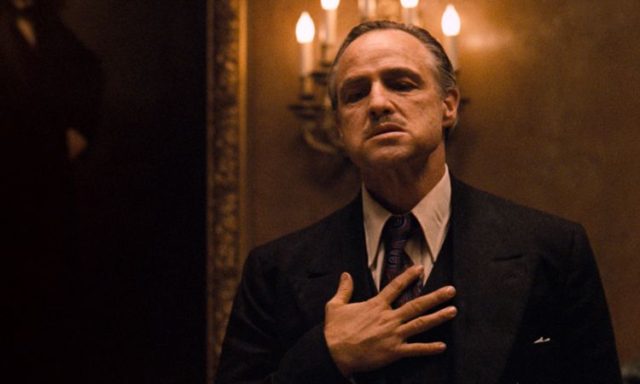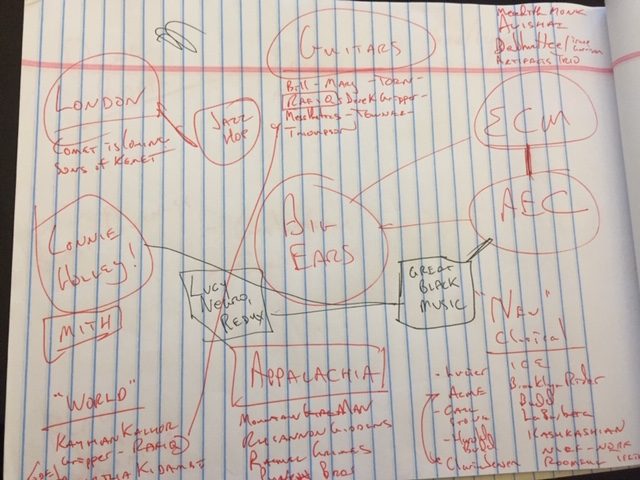Ears Embiggened: 50 Years of ECM

(The first in a series of preview posts as we count down to the
2019 Big Ears Festival in Knoxville, TN.)
Back in the old days – way before the internet machine made hearing just about any recorded piece of music in the world as easy as finding a homemade porno of some celebrity and/or politician – finding out about music beyond the typical commercial channels took some real work. Much of this involved poring over publications of varying literacy levels to find out who was playing with who, where, and how often.<fn>God bless the Village Voice.</fn> You had to spend time dialing in college and alternative radio stations (no internet radio! You had to be within hailing range.) and hoping against reason that the stoned DJ <fn>I resemble that remark.</fn> might remember to announce the name of the track you were dying to identify. Often, you would listen to six or eight more songs in a row, only to have the hapless jock (mea culpa) announce only the last two because, well, he forgot, man.
You had to haunt the record stores. There used to be mammoth stores – stores like Peaches and Turtles and Virgin – aisle after aisle of record bins sorted by genre, carefully filed in alphabetical order. This was for the new, sealed releases. Very expensive, at least 5 or 6 bucks a record.
Then there were the used record stores, meccas for music geeks where you could stand for hours flipping through the stacks hoping to find a gem that you could make off with for two clams, three if it was a double disc set. You could drop 20 bucks on a pile of records just on whim. Maybe you saw a name you recognized, or the album cover was cool. Whatever. If you liked it, you win. If you didn’t, you could bring it back the next week and trade it in for a dollar credit. A buck for a listen or two seemed like a deal.
After a while, you spent lots of time with the album covers, checking out the liner notes and musician credits. Patterns emerge. You start to recognize more names, and not just the players. Engineers and producers start turning up again and again – Rudy van Gelder, Bob Thiele, Teo Macero. You start to keep an eye peeled.
You learned to recognize the record labels. You started to realize that any Blue Note album was worth the 2 bucks. Same for anything on Impulse. Specialty labels like ESP Disk were always worth a tumble, even though you might end up with a squabbling wall of artifactual noise that all but obliterated whatever the music was trying to be.<fn>Many Sun Ra albums, especially on his El Saturn label, were like this, but you learned to buy them anyway because you just never knew what you might find.</fn>
And then there was ECM. Pretty standard rule of thumb: If you saw an ECM in the cutout bin, you bought it. If not for you, then for one of your pals. Don’t recognize the Scandinavian cascade of consonants and diacriticals? Don’t worry, just buy it. If it had Manfred Eicher’s seal of approval, it was worth the candle.

By the time I got serious(ly addicted) about vinyl collection and music that could be safely characterized as out-of-the-mainstream, ECM was a ten year old label with a solid reputation for attention to detail in curation, design, packaging, and recording quality. The covers were thick paper and beautifully printed, the liner sleeves a refined, no friction material, never rough paper. No cheap, junked vinyl here; the discs were heavy and thick, an obvious cut above the major labels pressings on horse chips. They had to be, you see: the ECM sound would not survive the surface noise of standard-issue vinyl.
What about that sound quality? The first few years of releases had varying sonic personalities, but by the mid-70s the characteristic ECM Sound was firmly established, notable for its cultivation of audible space and silence. Even on recordings that were somewhat wall of sound-ish (e.g., Steve Reich’s Music for 18 Musicians) Eicher’s close attention to microphone selection and placement provided clearly defined separation of instruments in the mix. Add to that a well-articulated stereo image and a layering of reverb that served to build a concert hall in your living room. And no matter who was playing, it was the same concert hall every time.
In a 1999 interview with Home Studio Magazine, Eicher explained that he
…listened to a lot of jazz records, mainly Impulse! Or ESP releases; I found the music very interesting, but I didn’t like the way it was produced, mainly because I felt something was lacking, a part of the message had disappeared. My main concern, when I founded ECM, was to respect every aspect of the music. That meant be able to hear every nuance of the instrument, every colour, and respect the dynamics of sound, as given by the musician. This was quite a different way of recording jazz, and public was sensible to it.”
Some of this attention to detail no doubt grew from his experience at the classical Deutsche Grammophon label, long admired for its close attention to audio excellence. <fn>DG is another label, like ECM, that has somehow managed to maintain fierce fidelity to its guiding principles and pursuit of quality, still going strong 120 years after its founding. Maximum Respect!</fn> But there is a marked difference between the ECM and DG sound signature. Eicher was drawn to the atmospherics of reverb – both natural and simulated – where DG cultivated a drier studio sound. One is not necessarily better than the other. Vive la difference! But one thing is certain: You could identify an ECM project within a few seconds of listening.
These days, that ECM aesthetic is more widespread, signal of the influence ECM has had on the way we record and listen to music in the wake of their example. (For better or worse, the whole “New Age” genre pretty much owes its existence to ECM and Eno’s Ambient Music releases.)
The sound – the company motto calls it “the Most Beautiful Sound Next to Silence” – took some critical shots from those who found it icy, cold, antiseptic. Because Eicher, and many of his favorite artists, were from Scandinavia, the label was dubbed “fjord music” and “the Great Northern Sound”. As with too many critical shorthands, the jibes are better as provocative copy than accurate description.
Still, the sound was an ECM signature, and on some releases (like Eberhard Weber’s 1979 Fluid Rustle, which happens to be the ECM debut of Bill Frisell), the sound itself is often more notable than the performance. Descriptions of ECM as the “beautiful music” label emerged, and not in a kind context. To be sure, there were more than a few releases that were just perfect for those 3 a.m. oh-god-I-just-can’t-come-down episodes, times when an ECM record provided just the right amount of sonic-envelopment and gentle massage. This aesthetic would find broader – and less satisfying – expression with the emergence of so-called New Age music from labels like Windham Hill in the 80s.
But the perception is at odds with the reality. Close listening to something like Fluid Rustle offers satisfying elements of compositional innovation, and the performances are superbly delivered. I won’t likely spin this one often, but there is more there, there, than meets the ear. And on balance, the ECM catalog is studded with recordings that are definitional in their realm, with ambitious releases from the likes of the Art Ensemble of Chicago, Dave Holland, Meredith Monk, Steve Reich, Arvo Part, &c. that more than make up for those releases that one might be tempted to dismiss as sonic wallpaper. More than a few people have told me in no uncertain terms that Reich and Part are really just fancy-pants Muzak. For myself, I had long considered Keith Jarrett’s Sun Bear Concerts, a ten-album set of solo improvisation recorded live in Japan in 1978, little better than background hum. Yet here I am, about 3 hours into the box’s roughly 7 hours of music, and I find myself in a serious re-evaluation of my opinion of Jarrett overall and this recording in particular. YMMV.
With the Big Ears Festival’s celebration of ECM’s 50th anniversary less than a month away, I find myself immersed in the ECM catalog, revisiting so much music that has fallen out of my regular listening rotation. Most of the label’s 1500 or so releases are available via your favorite streaming service. <fn>This is ECM authorized streaming, so you can listen guilt-free, though you should buy some of the recordings anyway. Streaming fees are not enough to keep them going for 50 years more.</fn> This is some deep nostalgia for me, a traipse through the soundscapes that helped establish my overall aesthetic philosophy about what music – and art in general – can accomplish in a world in need of healing action.
How I think about music, how I respond to certain creative gestures and techniques, owes much to the ECM ethos. (Especially to my favorite of their roster of artists, the Art Ensemble of Chicago.) My interest in music that comes from other realms and cultures, music that defies easy categorization, or music that can appear harshly repellent or deceptively beautiful at first listen but that reveals more and more depth with every listen. Music that asks us to open our ears to the unfamiliar, to the possibly difficult and challenging. This aesthetic informs my engagement with pretty much all creative work, both my own and from other artists.
If you get right down to it – and apologies for presuming to speak for the Big Ears director – I expect that this is similar to the formation of Ashley Capps’ aesthetic, too. We came of age around the same time and around a lot of the same music. (AC and I met at the Bijou Theater in Knoxville in 1980 at his presentation of the Art Ensemble, one of his first shows.) We both were college radio geeks, the kinds of people who would spend hours flipping through the cutout bins in search of some holy grail recording of someone only we knew about.
And that is likely why Big Ears resonates so strongly for me. When I look at the lineup, it is as though I had just sat down and made a list of the artists I really want to hear and see. It rings the bells that Manfred Eicher started pealing in my head 40 years ago, bells that have shaped much of my life since.
ECM was not the first label to establish such a distinct personality, nor the last. Labels like India Navigation, Soul Note, Black Saint, hatHut, and dozens more have since created powerful catalogs of work in the jazz realm, and Nonesuch is prominent in its delivery of important creative music after its humble origin as a discount bin classical label in 1964. But not many labels have the longevity of an ECM: Fifty years on, Eicher’s vision remains intact (albeit expanded to embrace more classical music since c. 1985) and the company’s business model presumably solid. Hell, 50 years in the recording industry is about three lifetimes. Certainly such a thing is impossible.
And yet, they persisted. Happy birthday, ECM, and thanks for everything.
(Credit to the Home Studio Magazine interview with Eicher and Tyran Grillo’s superb website, a heroic labor of love from a guy who just wanted to write a thoughtful review of every album ECM ever released. And immense thanks to the Big Ears Festival
for throwing ECM a big ass birthday hoolie this year.)

















